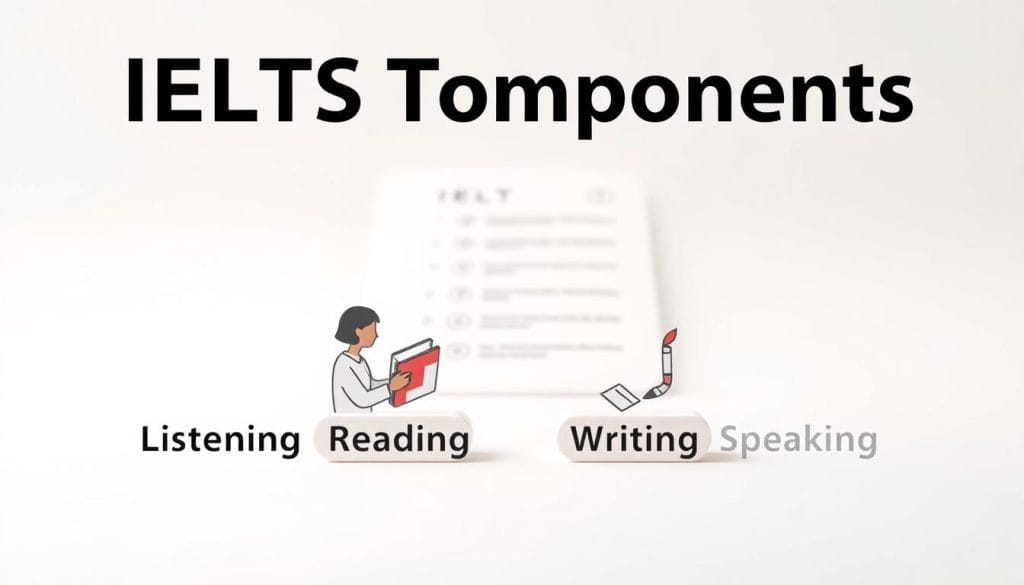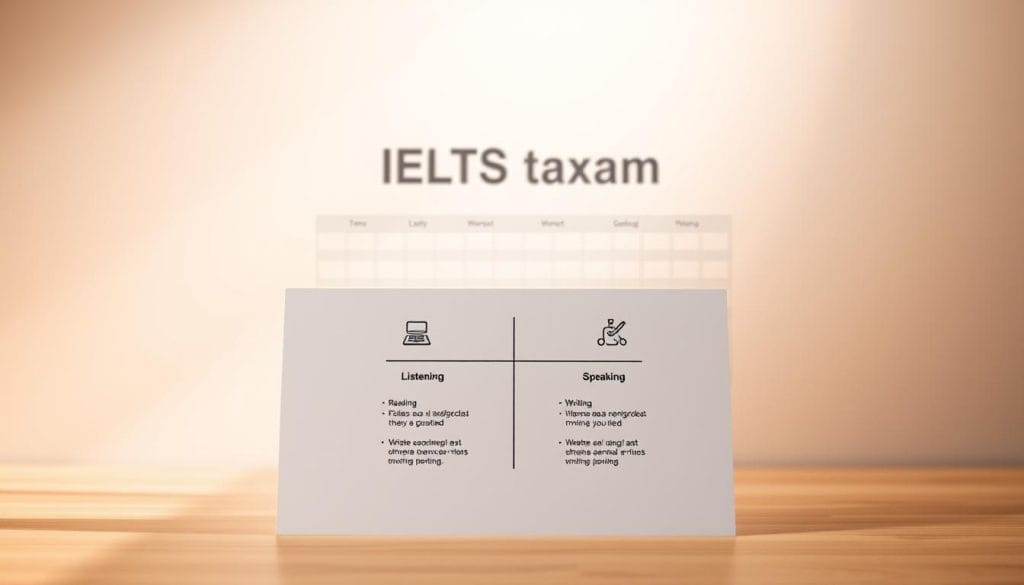Mastering the IELTS Exam
- The IELTS exam Pattern is a crucial step for individuals seeking to study or work in an English-speaking environment. With two formats available – Academic and General Training – it’s essential to understand the exam pattern to devise an effective preparation strategy.
- The test consists of four sections: Listening, Reading, Writing, and Speaking. Familiarizing oneself with the exam pattern helps in achieving a high score. Here are some key takeaways to keep in mind:
Key Takeaways
- The IELTS exam assesses a candidate’s language ability in four sections.
- Understanding the exam format is crucial for effective preparation.
- The Academic and General Training formats cater to different needs.
- A high score in the IELTS exam can open doors to new opportunities.
- Preparation strategies should be tailored to the individual’s goals.
- Familiarity with the exam pattern helps reduce anxiety and stress.
Overview of the IELTS Exam Pattern
The IELTS exam pattern is a crucial aspect of the test, and understanding its structure is vital for candidates. The IELTS exam is available in two formats: Academic and General Training. The Academic format is designed for candidates who wish to pursue higher education, while the General Training format is geared towards those who want to migrate or work.
Academic vs. General Training Formats
The Academic and General Training formats differ in their content and purpose. The Academic format focuses on assessing a candidate’s ability to understand and use complex academic language, while the General Training format evaluates a candidate’s ability to communicate effectively in everyday situations. Understanding these differences is essential for candidates to choose the right format for their needs.
Test Duration and Band Score System
The IELTS test is divided into four sections: Listening, Reading, Writing, and Speaking. The test duration and band score system vary depending on the format chosen. The Listening and Speaking sections are conducted on the same day, while the Reading and Writing sections are held on a separate day. The band score system ranges from 0 to 9, with most universities and institutions requiring a minimum score of 6.5 or 7.
Computer-Delivered vs. Paper-Based Options
Candidates can choose between computer-delivered and paper-based tests. The computer-delivered test is more convenient and flexible, while the paper-based test is more traditional. Understanding the differences between these options is crucial for candidates to make informed decisions.
Understanding the IELTS Exam Pattern
The IELTS exam pattern is designed to assess a candidate’s language proficiency. It is available in two formats: Academic and General Training. Understanding the differences between these formats is crucial for candidates.
Key Differences Between Formats
The Academic format is geared towards candidates who wish to pursue higher education, while the General Training format is designed for those who want to migrate or work. The content and structure of the two formats differ significantly.
Test Structure and Scoring
The IELTS test consists of four sections: Listening, Reading, Writing, and Speaking. The test duration and scoring system vary depending on the format chosen. Understanding how the test is structured and scored is vital for candidates.
Choosing the Right Test Format
Candidates can choose between computer-delivered and paper-based tests. Understanding the advantages and disadvantages of each format is essential for making an informed decision.
The Four Components of the IELTS Test
- The IELTS test is composed of four main components: Listening, Reading, Writing, and Speaking. Understanding the structure and requirements of each component is crucial for achieving a high score.
Listening Section
- The Listening section involves answering 40 questions in 30 minutes. Candidates must listen to four different recordings and answer questions based on what they hear.
Reading Section
- The Reading section requires different approaches for Academic and General Training candidates. Academic candidates must read three long texts, while General Training candidates read a mix of texts, including descriptive and argumentative passages.
Writing Tasks
- The Writing tasks include essays and reports, with specific requirements for each. Candidates must write a clear and well-structured essay or report within the given time frame.
Speaking Test
- The Speaking test is a three-part interview that assesses a candidate’s ability to communicate effectively. The test includes a discussion on a given topic, a presentation, and a conversation with the examiner.

Strategies for Mastering the IELTS Format
Mastering the IELTS format requires a thorough understanding of the ielts test scheme and effective preparation strategies. To achieve a high score, candidates must familiarize themselves with the exam pattern, including the Listening, Reading, Writing, and Speaking sections.
Practicing with sample tests is essential to improve time management skills, as candidates need to complete each section within the given time frame. Additionally, enhancing English language skills is vital to perform well in the test.
By understanding the ielts test scheme and adopting a well-planned preparation strategy, candidates can feel more confident and prepared on the test day, ultimately achieving their desired scores.
Read More:
Prepare for the UPSC Exam in 6 Months: Proven Strategies
How to Prepare for Bank Exams: A Step-by-Step Guide
FAQ
What is the IELTS exam pattern?
The IELTS exam pattern consists of four sections: Listening, Reading, Writing, and Speaking. It is available in two formats: Academic and General Training.
What is the difference between the Academic and General Training formats?
The Academic format is for those who want to study at a university or college, while the General Training format is for those who want to migrate or work.
How long does the IELTS test take?
The Listening, Reading, and Writing sections are completed on the same day, with a total duration of 2 hours and 40 minutes. The Speaking test can be taken on the same day or up to seven days before or after the other tests.
What is the IELTS band score system?
The IELTS band score system ranges from 0 to 9, with 0.5 increments. The overall band score is an average of the four sections.
Can I choose between a computer-delivered and paper-based IELTS test?
Yes, candidates can choose between a computer-delivered and paper-based IELTS test, depending on their preference and the test center’s availability.
What is the format of the IELTS Listening section?
The IELTS Listening section involves answering 40 questions in 30 minutes, with four sections and a variety of question types.
How does the IELTS Reading section differ between Academic and General Training formats?
The Academic Reading section includes more complex texts and requires a deeper understanding of academic language, while the General Training Reading section includes a mix of texts from various sources.
What are the Writing tasks in the IELTS test?
The IELTS Writing tasks include essays and reports, with specific requirements for each task and format.
What is the format of the IELTS Speaking test?
The IELTS Speaking test is a three-part interview that assesses a candidate’s ability to communicate effectively, including an introduction, a short presentation, and a discussion.
How can I prepare for the IELTS exam pattern?
To prepare for the IELTS exam pattern, candidates should familiarize themselves with the test format, practice with sample tests, and improve their English language skills.

